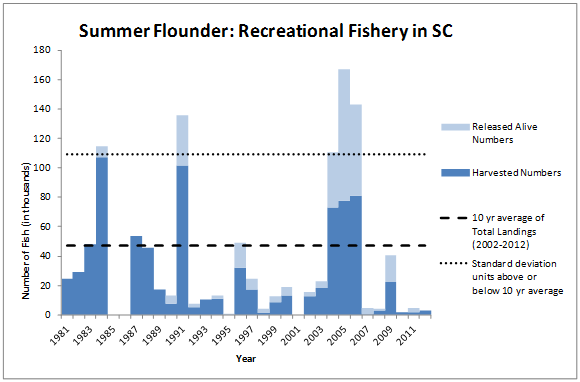Marine - Species - Summer Flounder
Recreational Fishery in SC

Recreational catch in South Carolina for summer flounder is highly cyclical due to South Carolina being at the southern end of their distribution range. Peak years occurred in 1984, 1991, and 2004-2006, with catch levels in most of the other years well below the most recent 10 year average (47,141 fish per year). Catches after 2006 dropped off and has stayed well below the 10 year average.
Commercial flounder landings are not tracked by species, but combined as group to include all species of the genus Paralichthys. Total commercial landings for flounder in South Carolina have been steadily declining since the 1980's. The recent 10 year average (2001-2011) of 3,148 live pounds is significantly less than landings in the 1980's (52,972 live pounds) and the 1990's (12,108 live pounds). The primary gear targeting flounder in South Carolina in recent years include both trawls and gigs.
The recreational catch data is provided by the National Marine Fisheries Service (NMFS), which conducts phone and angler-intercept surveys to monitor angler activities and catches. For more information see: https://www.st.nmfs.noaa.gov/.
The commercial fisheries data is provided by the National Marine Fisheries Service (NMFS), which compiles commercial information provided by state agencies. For more information, see: https://www.st.nmfs.noaa.gov/.
Additional Graph Information
Commercial and recreational catches are measured in number of individuals or pounds of fish caught. Changes in catch among years may be the result of changes in abundance, fishing effort, or a combination of the two.
On each graph, the horizontal dotted lines above or below the "10 year average" represent one "standard deviation" unit, which is a measure of how variable the annual data are around the 10-year average. In general, the area between one standard deviation above the mean and one standard deviation below the mean includes approximately 68% of all values. Approximately 95% of observations in the data set are found within two standard deviation units of the average and is referred to as the prediction interval.
